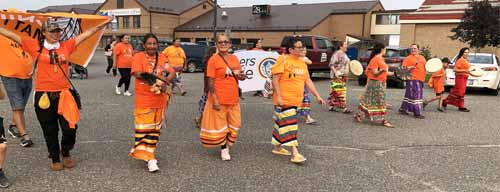Darlene Wroe
Speaker Reporter
TEMISKAMING SHORES – Patricia Ballantyne of the Peter Ballantyne Cree Nation of Saskatchewan brought the Walk of Sorrow to Englehart and Temiskaming Shores on August 5.
The walk is in honour of the children who died in residential schools in Canada.
Ballantyne and her supporters were greeted by the Keepers of the Circle and other members of the community in New Liskeard Thursday, and together they walked from the Little Claybelt Homesteaders Museum to the shore of Lake Temiskaming.
Ballantyne said her group planned to remain in the area for a couple of days before continuing on.
Ballantyne attended the Prince Albert Residential School from the time she was four-and-a-half until she was 15, from 1978 to 1987.
When it was announced unmarked graves were discovered at residential schools in May of this year, Ballantyne took her backpack and prepared to leave to walk to Ottawa to speak in person to the Minister of Crown-Indigenous Relations and Northern Affairs, Carolyn Bennett.
As a residential school survivor, Ballantyne felt the need to begin her own journey of healing.
“I didn’t intend it to be out there like this,” she said as she stood in front of the memorial display at the Inukshuk beside Lake Temiskaming in New Liskeard.
“I intended on going out alone. I just had a backpack and I was ready to leave.”
THOUSANDS OF KMS
She began her journey on June 5, but as the kilometres fell away, a growing number of people joined her, including family members and others.
“Just to get this much support and love and encouragement is incredible,” she commented.
Although the Walk of Sorrow has nearly reached its destination, for Ballantyne, she expects her own healing journey will never be over.
“I don’t think I will ever be over it,” she said of her experience at the residential school.
“It was such a traumatic experience for me, with all the violence, the sexual abuse, the mental abuse and spiritual abuse. It’s going to be a long journey. I will be dealing with this for the rest of my life. I’m just trying to find some healing inside myself, and trying to find better ways to deal with my life, rather than turning to alcohol and rather than being depressed all the time.” She added that she suffers from depression and anxiety “so I find this walk is doing me a lot of good.”
As she and her fellow walkers have journeyed across the Prairies and Ontario, they have met thousands of people.
“Every community we stopped and walked by, they come out and support us.”
By the time Ballantyne had reached New Liskeard, she was wearing her tenth pair of shoes purchased along the way to replace those that had worn out.
“We walked through rain, heat waves, cloudy, smoke…. You name it, we walked through it all, even the very windy days in Saskatchewan, we walked through that, so we had windburn and sunburn at the same time,” she said with a laugh.
There will be a few more stops and Ballantyne expects to reach Parliament Hill in Ottawa in two to three weeks.
Her goal is to educate people on how residential schools have damaged Indigenous communities and people, she said, and continue to cause damage “through the child welfare system and the foster system. We want them to hear how bad it was in there and we want them to acknowledge that. Even with the day schools, it was just as bad as the residential schools, so we just want to continue that education.”
She said the goal is to have First Nations people in the child and family services system and in those leadership roles, “because we are the ones who know how we can raise our children best. We don’t need the government continuing to tell us how we should be raising our children, and how our communities should be run,” said Ballantyne.
Following a meeting with Bennett in Ottawa, Ballantyne said the group plans to go to British Columbia to walk there.
A Walk of Sorrow website has been established for those who would like to donate to support the costs associated with this journey.

 The Walk of Sorrow, led by Patricia Ballantyne of Prince Albert, Saskatchewan, (second from left) has been gathering followers as she marches toward Ottawa on a journey of healing. Ballantyne is a residential school survivor. She and those who accompany her arrived in Temiskaming Shores on August 5. They are pictured here nearing the shore of Lake Temiskaming. (Staff photo by Darlene Wroe)
The Walk of Sorrow, led by Patricia Ballantyne of Prince Albert, Saskatchewan, (second from left) has been gathering followers as she marches toward Ottawa on a journey of healing. Ballantyne is a residential school survivor. She and those who accompany her arrived in Temiskaming Shores on August 5. They are pictured here nearing the shore of Lake Temiskaming. (Staff photo by Darlene Wroe)